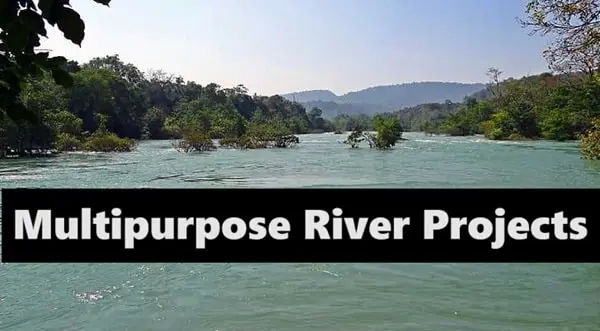Multipurpose River Projects are large-scale infrastructural projects to use the resources of a river for multiple complementary purposes at the same time. Such projects typically involve river regulation and harnessing through construction of dams, reservoirs and canals, to generate hydroelectric power, provide irrigation water, water for domestic and industrial use, flood control, inland navigation, fish breeding etc. By using rivers to simultaneously attend to several needs, they look to gain maximum benefit from river systems, contributing to economic growth, agricultural productivity and overall development in that particular region.

Advantages of Multipurpose River Projects
1. Reliable Water Supply
So, the first and big benefit of the multipurpose river projects is that they can provide reliable water supplies for urban and domestic use, and even for industrial purposes. Simply put, storing water in large reservoirs helps to cater for the increasing requirements of households and industries in cities, resulting in better quality of life and of course the economic growth comes with that.
2. Clean Electricity Generation
These are projects also used in producing energy from flowing water, so-called hydroelectric power, tapping a renewable energy source by once more reducing our dependence on fossil fuels and contributing to the growth of renewable energy in the world, powering homes, towns and factories.
3. Flood Control
And yes, another big positive of such river products is that by controlling river flows, such projects prevent catastrophic flooding. The reservoirs store water and release it gradually through the dry season, protecting people and assets in areas prone to flooding, you know?
4. Enhanced Irrigation
One major reason why these projects even exist in the first place is that they play an important role in providing water to irrigate agricultural lands. Multipurpose river projects can transfer water to a limited number of farm lands from main water supply to help farmers maintain water supply especially in dry areas which ultimately results in crops yield increasing.
5. Improved Inland Navigation
And you might not have thought of this but, these projects, by maintaining the water level and keeping the channels clear, open up rivers to transportation, leading to new paths for goods and humans, leading to less congested roads and reduced transportation costs.
6. Recreation and Tourism
Dams and reservoirs generated by these projects become centers of recreation, serving as spots for boating and fishing and thus becoming tourist sites that improve the local economy and residents’ living standard. So, that is pretty much the possibility with these river projects.
7. Soil Erosion Prevention
And yes, how can we even forget about soil erosion? Well, by keeping water flow steady and preventing soil erosion, multipurpose river projects help maintain soil fertility and prevent land degradation. This is ultimately good for the agriculture in the area where the multiple-purpose river project is intended to serve.
Disadvantages of Multipurpose River Projects
1. High Initial Costs
For one, there are the huge dams and huge reservoirs. And all the associated infrastructure that goes with them. These are big budget items. Plus, if you think about the time it takes to build these projects, several years at best, closer to several decades at worst, often the total price tag just keeps increasing.
2. Hurting the Environment
And speaking of Mother Nature, multipurpose river projects are not her friends. Dams and reservoirs (essential components of multipurpose river projects) generally involve clearing forests and plundering biodiverse landscapes. Drowning large sections of land also takes a toll on natural ecosystems. Furthermore, changing the course of a river affects ecosystems downstream, which are entirely dependent on the way the river used to be, you know?
3. Displacing People
Let’s start with the most challenging example: people getting evicted from their homes. When you need to fill up a large body of water, all those lucky folks who live in its sphere have to go. Evictions can throw lives into mayhem: people’s homes, farms and livelihoods can be ripped away overnight.
4. Messing with Aquatic Life
So it’s not just the terrestrial creatures who get hurt, our aquatic friends bear the brunt as well. Dams often block fish migration routes, affecting spawning and altering population dynamics, and this is just one of the issues that arises from a mega-structure in a river, you see, changes in temperature, flow and decreasing quality can also cause dread among aquatic life.
5. Soil Quality Goes Downhill
Oh, and, watch out for the land in the vicinity of these river projects, it could become less fertile too. In some cases, waterlogging and salinity can result when water is held back or diverted, or both, pushing the water table up (which can create boggy ground) or else concentrating salts in the soil (which decreases fertility). Both can be serious agricultural problems, lowering productivity and forcing a costly response.
6. Sediment Buildup
See, when you slow the flow of a river by daming it, the sediments that would normally flow downstream start to drop wherever water accumulates. What this means is that over the years, reservoirs begin to fill up with this sludge, which decreases the amount of water they can hold and decreases water quality. And you can call this a literal maintenance nightmare, if you will.
7. Losing Agricultural Land
And what about the land? In addition to drowning agricultural landscapes, giant reservoirs also destroy fertile farmland that can’t be simply replaced. Losing agricultural land can impact local food production, mess with farmers’ lives. All in all, it is about much more than losing fields: it’s about threatening food security in places where agricultural development means life itself.
Quick Comparison Between Advantages and Disadvantages of Multipurpose River Projects
| Advantages | Disadvantages |
| Reliable water supply for urban, domestic, and industrial use | High initial costs and long construction periods |
| Clean hydroelectric power generation | Environmental damage from deforestation and ecosystem disruption |
| Flood control and prevention | Displacement of local populations |
| Enhanced irrigation for agricultural lands | Negative impact on aquatic life and fish migration |
| Improved inland navigation and transportation | Reduced soil fertility due to waterlogging and salinity |
| Recreation and tourism opportunities | Sediment buildup reducing reservoir capacity and water quality |
| Soil erosion prevention | Loss of fertile agricultural land and threat to food security |


